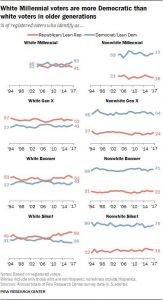The following article by Eleanor Clift is cross-posted from The Daily Beast:
Macomb County, Michigan is where Democrats go for the hard truths to save their party. The working-class suburb of Detroit sent Bill Clinton to the White House and delivered two solid wins for Barack Obama before turning on the Democrats and giving Donald Trump 54 percent of its votes.
Globalization stole many good-paying jobs from Macomb, leaving fertile ground for Trump’s anti-trade message. Democrat Debbie Dingell, who represents the Detroit area — as her husband did before her, and his father before him – recalled to the Daily Beast how she confronted Hillary Clinton during the 2016 campaign.
“I told her in no uncertain terms, if you leave Michigan and people here don’t know you’re opposed to the TPP (Trans-Pacific Partnership), and will be opposed to it when you’re president – You can just forget it,” Dingell said.
She meant forget being president, which is what happened. Dingell still gets exercised over how her frantic calls for action then were ignored. “Anybody I talked to, I said it was a problem,” she recalled. “It was clearly a problem in Michigan. I was told not to worry, everything was fine.”
Democrats were so confident the “blue wall” would hold that Clinton made just one trip to Michigan that August, telling workers at Futuramic Tool & Engineering in suburban Detroit that she was against TPP, and would be as president. It wasn’t reassuring, not with President Obama openly lobbying for the trade deal, telling naysayers it would get done in the lame duck Congress after the election.
“Obama wanted it as a legacy issue, and that left her (Clinton) clearly muddled and jumbled,” Democratic pollster Stan Greenberg told the Daily Beast. “Trade was a major factor in Trump’s victory, and she was perceived to be ambivalent. She was so concerned with not appearing to have any distance from Obama on the economy.”
According to Greenberg, Obama called into the platform committee before the Democratic Convention to change the wording to be less critical of TPP. Dingell was “apoplectic about TPP and Clinton not being clear,” says Greenberg, as was his wife, Democratic Rep. Rosa DeLauro of Connecticut. The two women conveyed their anger to Clinton campaign chairman John Podesta, apparently to no avail.
“I hate to be Debbie Downer again, but you can’t take this for granted,” says Dingell, sounding the alarm ahead of the November midterm elections for Democrats to up their game. “You don’t know how many people will stay home out of general disgust or think their vote doesn’t matter.”
Greenberg shares her angst about Macomb. He has made a career out of monitoring attitudes in the working-class suburb. The insights he gleaned more than 25 years ago paved the way for Bill Clinton to reorient the Democratic Party more to the center, allowing a Democrat to win the White House after 12 years in the wilderness.
The veteran pollster says Democrats don’t yet have a winning economic message that speaks to the real struggles people are having. Rising health care premiums top the list, he says. “I can’t tell you how powerful the health care issue is. People are in tears about the cost of health care, and they blame the Republicans.” The salience of the health care issue is a key takeaway from focus groups Greenberg conducted in March in Macomb with Trump voters and Detroit area base voters. He found that white college-graduate women “seemed as much a base, anti-Trump group as the African Americans.”
Greenberg sees Macomb as a bellwether for the country. In 2008, these working-class voters supported Obama, making a judgment about him that transcended race, “that he wouldn’t just work for his own folks, he would work for everybody.”
They voted for Obama because of economic self-interest, and they voted for Trump for the same reason. Working-class men in Macomb support Trump by two to one, and many have paid a high price for their vote in their own family. The politicized, polarized civil war in the country is in the family, says Greenberg, with older voters blaming the mainstream media’s “fake news” for their millennial children failing to understand what Trump is trying to do.
“Clean up corrupt government is not enough for them. Identity politics are not enough,” he says. Asked what he thinks of the Democrats’ new slogan, Better Deal, he replies, “Not a fan of it.”
The 1992 election that propelled Bill Clinton to the White House was famously staked on the phrase “It’s the economy, stupid.” Greenberg still thinks that has to be the bedrock message even with another month of positive job numbers released last Friday. People believe the economy is growing and more jobs are available, “but that has not diminished their frustration and insecurities about their stagnant pay in the face of rising costs,” Greenberg writes in his latest report on “Macomb and America’s New Political Moment.” Anti-Trump voters are consolidated and motivated, “and increasingly intent to vote,” Greenberg concludes. “They are seeking out tools and information to win arguments” and to convince themselves that Democrats have a vision that is about more than just reflexively resisting Trump.
It is a time unlike any other in recent history when the stakes are so elevated that both sides speak about a virtual civil war in the country, and in their own families.
Anti-Trump voters are consolidated and motivated, “and are increasingly intent to vote,” Greenberg says. “They are seeking out tools and information to win arguments,” and to convince themselves that Democrats learned from the last election and have a vision for the economy, and for the country, that is about more than Trump.





